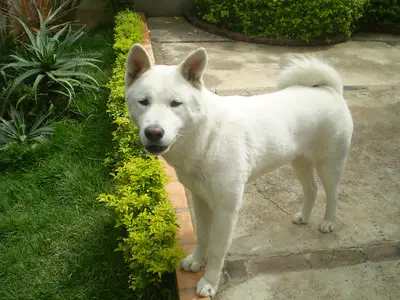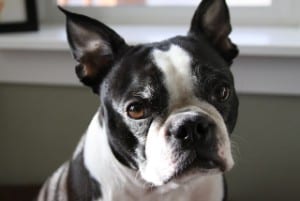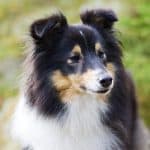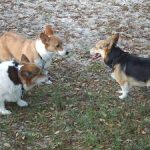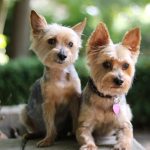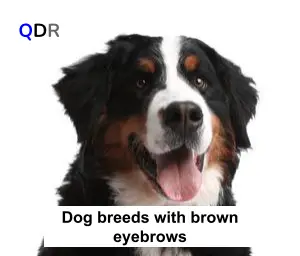
Many breeds of dogs have brown dots or spots over their eyes. This is common in those dog breeds who have a black and tan combination, such as Rottweilers. These dots over the eyes give the impression that the dogs have brown eyebrows. Dogs don’t have eyebrows because they have no need for them. The function of eyebrows is to protect the eyes from sweat and since dogs don’t sweat (on their head at least) they don’t have eyebrows.
This article contains a list of 7 breeds of dogs that have dots over their eyes- Australian Kelpie, Rottweiler, German Shepherd, Bernese Mountain Dogs, Gordon Setters, Dobermans and Miniature Pinscher.
7 breeds of dogs with brown eyebrows
1. Australian Kelpie
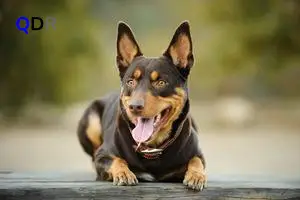
The Australian Kelpie, also known as Kelpie, were originally bred in Australia. The American Kennel Club (AKC) recognises 7 colours for this breed; black, black and tan, fawn, red and tan, red, chocolate and blue. Of these seven colours, eyebrows will be seen on black and tan, red and tan and fawn coloured Kelpies. These dogs have short, smooth double coats. This coat helps this breed to live and work in the hot Australian climate. Their coat doesn’t need much grooming.
Kelpies are middle-sized dogs, weighing anywhere between 30-50 lbs (13. 6 kg- 22.68 kgs). Kelpies aren’t great family dogs. Although they are easy to train and very intelligent, they aren’t the best dogs to have with young children. Neither are Kelpies the most affectionate of dogs. Australian Kelpies need a lot of exercise as well as needing a lot of mental stimulation to keep them happy.
2. Rottweiler
Rottweilers are also known as Rotties. Rottweilers originated in the German town of Rottweil. They were bred to protect livestock and to guard their owners from bandits. An antecedent of this breed can be traced back to the Romans. The AKC recognise three colour combinations in Rottweilers- black and tan, black and rust and black and mahogany. The AKC breed standard requires a Rottweiler to have a spot over each eye. Dogs with any of these combinations may have dots over their eyes. Pedigree Rotties should also have spots on their cheeks, a strip of rust around their muzzle as well strips on their throat.
Rottweilers are a large, solidly built breed of dog. An adult male can be up to 27” tall (68.58 cm) and can weigh anywhere between 95 and 135 lbs (43.09 kg- 61.23 kg.) Like many other large dogs, Rotties can be very affectionate, loving and playful. These dogs are intelligent and easy to train. In fact Rotties need more mental stimulation than they do exercise.
3. German Shepherd
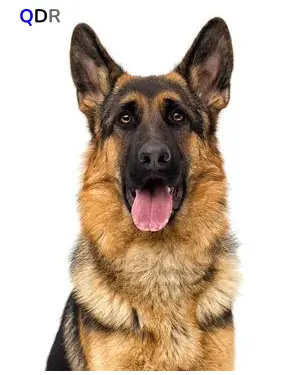
German Shepherds, also known as Alsatians, are renowned for their intelligence and versatility. Originating in Germany in the late 19th century, they were initially bred for herding sheep. This breed quickly gained popularity due to its exceptional working abilities and soon found roles in police and military work.
The American Kennel Club (AKC) recognises 11 colours or colour combinations for this breed; Black, black and cream comma black and red, black and silver, black and tan, grey, sable, white, liver, blue, bi- colour. The AKC breed standard 4 German Shepherds doesn’t require that we have a coloured spot over their eyes. the color combinations that are most likely to have a spot over each eye are; black and cream, black and red, black and silver or black and tan.
Temperamentally, German Shepherds are recognized for their loyalty, intelligence, and adaptability. They are often considered excellent family dogs, displaying protective instincts. Daily exercise is crucial for their well-being, requiring approximately 1 to 2 hours to keep them mentally and physically stimulated.
Training German Shepherds is generally straightforward, thanks to their high intelligence and eagerness to please. Socialization is essential to manage their protective instincts appropriately.
Health-wise, German Shepherds may be prone to conditions such as hip dysplasia, elbow dysplasia, and certain genetic issues.
4. Bernese Mountain Dogs
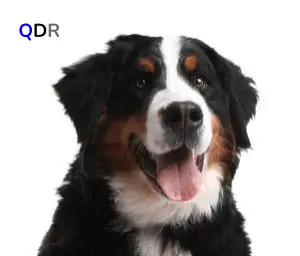
Bernese Mountain Dogs, often nicknamed Berners, are a distinctive breed known for their gentle temperament and striking appearance. Originating in the Swiss Alps, they were originally bred as farm dogs, excelling in herding and pulling carts. Dogs are tri-coloured. Black is the base colour. The akc breed standard requires Berners to have a strip of rust over each eye giving the appearance of having eyebrows. Also there are other strips of rust around their mouth as well as many other distinctive markings.
Temperamentally, Bernese Mountain Dogs are characterized by their affectionate nature and devotion to their families. They are known for being gentle with children and getting along well with other pets. Despite their size, they often have a calm demeanor.
Daily exercise is important for Bernese Mountain Dogs, requiring around 30 to 60 minutes to keep them physically and mentally stimulated. Due to their herding background, they may have a natural inclination to work.
Training Bernese Mountain Dogs is generally manageable, given their intelligence and eagerness to please. Early socialization is essential to ensure they grow into well-mannered adults.
Health-wise, Bernese Mountain Dogs may be prone to certain conditions such as hip and elbow dysplasia, as well as certain heart issues.
5. Gordon Setter
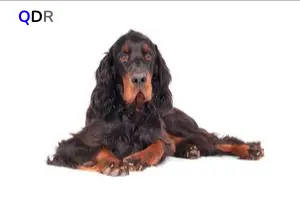
Gordon Setters, often referred to as Gordons, are a distinctive breed with a rich history. Originating in Scotland, they were initially bred for their exceptional hunting skills, particularly in game bird retrieval.
Gordon Setters boast a luxurious coat that is predominantly black with tan markings. The coat is straight, silky, and of medium length, requiring regular grooming to prevent matting. The AKC breed standard requires that a Gordon Setter has a tan spot over each eye that shouldn’t be any larger than three quarters of an inch. Gordons should also have two large tan spots on their chests as well as Having a tan stripe around the end of their muzzle.
Temperamentally, Gordons are known for their intelligence, loyalty, and gentle nature. They make excellent family companions, often getting along well with children and other pets.
Daily exercise is essential for Gordon Setters, necessitating about 1 to 2 hours to satisfy their energetic nature. Engaging them in activities like retrieving or agility exercises contributes to their mental and physical well-being.
Training Gordon Setters is generally manageable, given their intelligence and eagerness to please. Early socialization is crucial to prevent shyness or timidity.
Health-wise, Gordon Setters may be prone to certain conditions such as hip dysplasia and progressive retinal atrophy.
6. Doberman
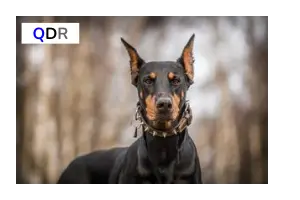
Dobermans, often referred to as Doberman Pinschers or Dobies, have a compelling history. Originating in Germany during the late 19th century, they were initially bred by a tax collector named Louis Dobermann to create a loyal and protective companion for his work.
Dobermans exhibit a short, sleek coat in four possible colours: , red, blue and fawn. There should be a rust spot above each eye and also there should be rust markings around their muzzle and their throat as well as on other parts of their bodies. A Dobie’s coat is smooth and lies close to their body, requiring minimal grooming.
Temperamentally, Dobermans are known for their intelligence, loyalty, and alertness. They make excellent guard dogs and family protectors, displaying both courage and adaptability.
Daily exercise is vital for Dobermans, requiring approximately 1 to 2 hours to channel their energy positively. Engaging in activities like running, playing, or obedience training contributes to their overall well-being.
Training Dobermans is generally straightforward, given their high intelligence and eagerness to please. Early socialization is crucial to ensure they develop into well-mannered adults.
Health-wise, Dobermans may be prone to certain conditions such as hip dysplasia, dilated cardiomyopathy, and von Willebrand’s disease. Regular veterinary check-ups, a balanced diet, and maintaining a healthy weight are essential for their overall health and longevity.
7. Miniature Pinscher
Miniature Pinschers, commonly known as Min Pins or “King of the Toys,” have a lively history. Originating in Germany, they were selectively bred to resemble smaller versions of the Doberman Pinscher.
Their sleek coat comes in 11 different color combinations; including red, stag red, black, or chocolate with rust markings. The coat is short, smooth, and requires minimal grooming.The AKC breed description for Min Pins require that dogs in the black and rust and dogs with the chocolate and rust colour combinations have spots over their eyes.
Temperamentally, Miniature Pinschers are known for their bold and spirited nature. Despite their small size, they possess a confident and fearless demeanor, often displaying a strong sense of loyalty to their families.
Daily exercise is crucial for Miniature Pinschers, requiring around 30 to 60 minutes to keep them physically and mentally stimulated. Engaging in play, short walks, or obedience training contributes to their overall well-being.
Training Miniature Pinschers is generally manageable, given their intelligence and eagerness to learn. Early socialization helps them develop good manners and adaptability.
Health-wise, Miniature Pinschers may be prone to certain conditions such as patellar luxation and Legg-Calve-Perthes disease.
FAQs
Do dogs have eyebrows?
Very few dog breeds have eyebrows comparable to ours and the main reason for that is that dogs don’t need them. In humans, eyebrows serve a practical purpose, to keep sweat from getting into the eyes. Dogs don’t sweat like humans as they only have sweat glands in their paws.
On the other hand, eyebrows also serve to communicate feelings. On their own, those small patches of hairs over the eyes wouldn’t do anything, it’s the muscles underneath that do the job of moving the eyebrows. Oddly enough, most animals don’t have such muscles (or eyebrows, for that matter). Dogs do.
They have one short and strong muscle that allows them to raise an eyebrow so to speak. Humans have two such muscles. According to one Australian study, having muscles to move the eyebrows is a characteristic of highly social animals. For instance, wolves, dogs’ distant ancestors, have more facial expressions than foxes which are solitary animals.
Why do some dogs breeds have spots over the eyes?
The spots you can see over the eyes of certain dogs are known as tan points. It’s a trait mostly seen in breeds that belong to the black-and-tan phenotype. The black and tan color is dictated by a gene called Agouti. This gene comes in several versions, called allele.
The coloring and the markings on a dog’s fur depends on the specific allele he inherits from his parents. This is a recessive gene, so the dog will have a distinctive black-and-tan color if the genes he got from his parents are of the same type.
The tan points can appear as pips over the eyes, on the sides of the muzzle, on the cheeks, on the front of the chest, or sometimes on the legs.
Some predominantly tan dogs can have black spots over the eyes, but this is extremely rare.
What purpose do the spots over a dog’s eyes serve?
There’s very little research on the role facial markings play, but it’s a known fact that dogs communicate a lot with their eyes. Two dogs staring at each other is a sign of tension and potential trouble, whereas a dog looking away is trying to diffuse the tension. The eyebrow muscle helps a dog make his eyes appear bigger, and so do the spots.
Another theory says that the tan points serve as decoy. When a dog sleeps with his eyes close, the tan points might appear as eyes, at least from a distance, giving the impression that the dog is alert. However, that would have made sense long ago, before dogs were domesticated.
Nowadays, dogs use their eyebrows to communicate better with us. According to one study, dogs use more facial expressions when they’re ‘talking’ to a human then when their owner has his face turned away and not looking at the pet. It seems almost as if dogs evolved this sort of mock-eyebrow to better communicate with humans.

